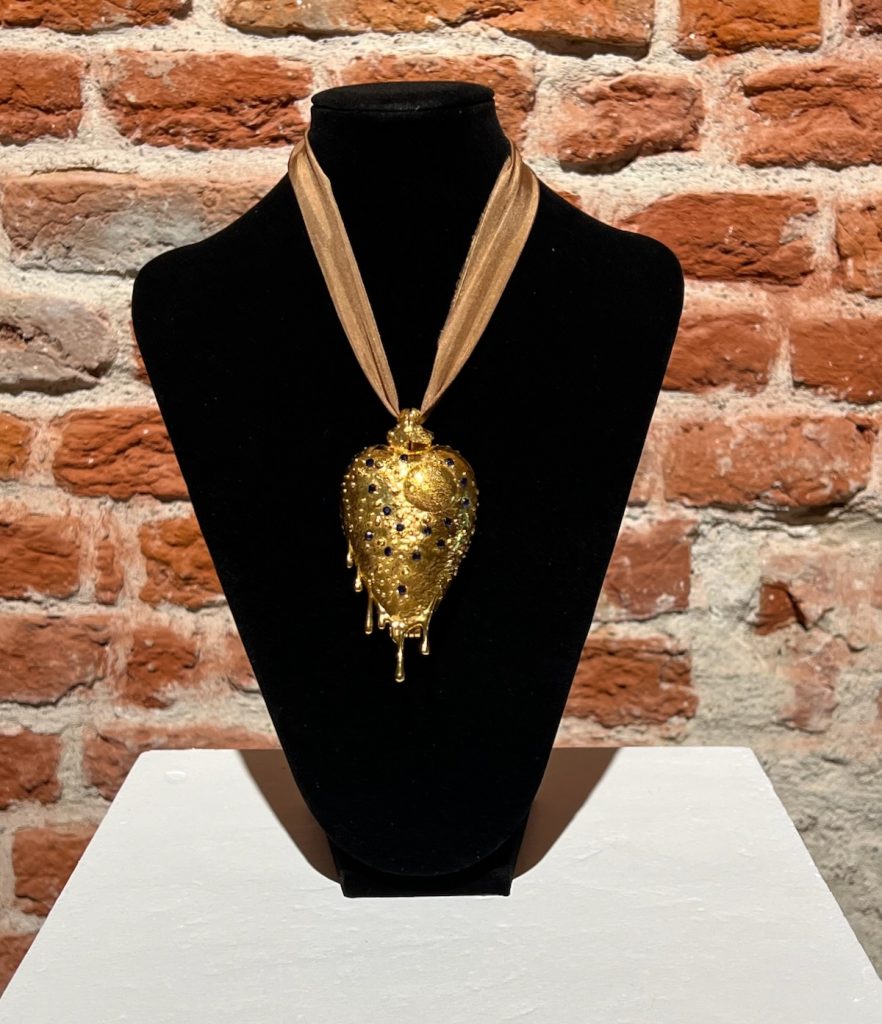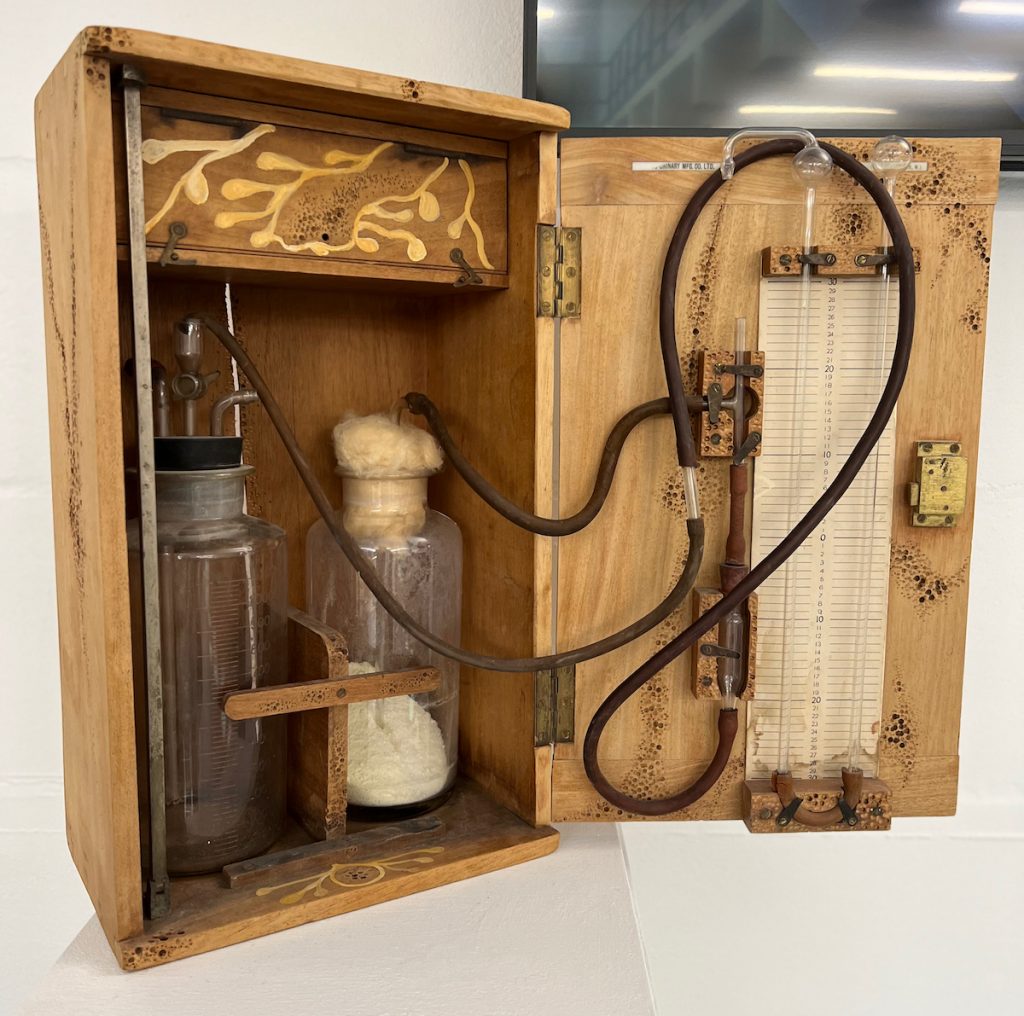The “Entangled Health” series was created when Anna Dumitriu became the first Artist in Residence at the University of Surrey working alongside Faculty of Health and Medical Sciences over the 2021-22 academic year.
Since over 70% of emerging infectious diseases in humans originate in animals, the residency explored the complex interrelationship of animal and human health, a concept described by the World Health Organisation as ‘One Health’. This holistic approach brings together pathogens, humans, wildlife, livestock, and their environments. The project explored entangled disease ecosystems and the many and varied issues that stand in the way of tackling infectious diseases. Exploration of ‘One Health’ from an artistic perspective complements research at Surrey on zoonotic diseases (those that spread from animals to people).
The work produced during the residency was premiered at the University of Surrey on 21st June 2022 and there was a public reception and ‘in conversation’ event. The work was also shown as part of the Cutting-Edge Methods in Physics for Studying Intracellular Bacterial Pathogen Interactions with Host Cells and Small Molecules conference on 22nd and 23rd June 2022 where Dumitriu gave a talk about her work on 22nd June 2022.
The residency was made possible thanks to a successful Institute for Advanced Studies (IAS) fellowship application by Anna and her host at the University, Professor Mark Chambers.
- Skip to “Zenexton“
- Skip to “Unruly Objects: Living Latex“
- Skip to “aDNA“
- Skip to “Quantum Biology Embroidery“
- Skip to “Entangled Health“
Zenexton (2022)

Materials: 3D printed PLA, silk ribbon dyed with walnut, ChAdOx1 Plague vaccine
In around 1570 Theophrastus Paracelsus coined the mysterious term Zenexton, to mean an amulet that would be worn around the neck and protect the wearer from the plague. Until that time amulets had a more general purpose of warding off (unspecified) disease, rather like the difference nowadays between ‘broad spectrum’ antibiotics versus antibiotics carefully targeted to a specific organism informed by genomics approaches. Paracelsus said he did not believe he would invent an effective Zenexton in his day, and that it was a task for future generations. In over the next one hundred or so years, something like a twisted version of the scientific method as we know it followed over what the Zenexton should contain, for example: a paste made of powdered toads, sapphires that would turn black when they leeched the pestilence from the body, amber if you couldn’t afford sapphires, menstrual blood and so on. Bizarre improvements were later made to the concoction, ‘of course’ they reasoned, ‘the toad should be finely powdered’, ‘the menstrual blood from a virgin’, ‘collected on a full moon’ and so on.
Unlike the concoctions of that era this contemporary Zenexton offers the wearer something that will genuinely protect them, as it contains a recently developed vaccine against Yersinia pestis (the bacterium that causes plague) developed by Professor Christine Rollier and colleagues at the University of Oxford using the ChAdOx1 platform (the same vaccine platform used to create the Oxford/Astra Zeneca COVID-19 vaccine). This amulet is 3D printed, and its design references the history of the Zenexton including contemporary laboratory made sapphires.
University of Surrey Collaborator: Professor Christine Rollier with thanks to the Oxford Vaccine Group.
Exhibitions
“Life Eternal” curated by the Nobel Prize Museum 1st October 2022 – 29th January 2023 at Liljevalchs Konsthal in Stockholm (Sweden).
Unruly Objects: Living Latex (2022)

Materials: Carved marble, living latex with Cyanobacteria, acrylic paint, plant seeds, mud from a Winogradsky Column
This project explores research taking place at the University of Surrey by Simone Krings, Dr Suzie Hingley-Wilson and Professor Joseph Keddie to reduce the impact of climate change by capturing carbon using cyanobacteria which are encapsulated into a kind of ‘living latex’.
Cyanobacteria (or blue-green algae) live in all types of water and are believed to be at the origin of plants. By their carbon capturing properties and oxygen evolution, they had a huge impact in the history of the earth. Encapsulating these bacteria into synthetic latex allows them to be coated onto any surface, therefore creating functional paints.
These new sculptural works build on Anna Dumitriu’s series entitled Unruly Objects and Biological Conservation and continue to explore the relationship of conservation of antiquities, and the potential collection and conservation of contemporary living biological sculptures by museums, such as her own BioArt works.
The use of latex in work also references a 2014 paper by Fernando Domínguez Rubio “Preserving the Unpreservable: Docile and Unruly Objects at MoMA” in which he discusses whether Eva Hesse’s latex artwork “Expanded Expansion” should still be displayed, saying “the original translucent and ethereal sculpture has now become a yellow, brittle artifact. The physical transformation has been so radical that it has prompted a wide controversy in the art world as to whether this piece should be exhibited at all.” This is ironic as the white marble classical sculptures that fill our museums are radically different from the brightly painted objects that originally adorned sites of antiquity.
The work here also builds on her collaboration with the Department of Antiquities and Works of Art University of Western Attica in Athens which explores their research into ways to augment and enhance the microbiomes of sculptural antiquities to prevent or arrest their further decay (CO2 damage is a particular issue), and her Fermenting Futures series with BOKU University which explored the carbon capturing properties of yeast and the microbiomes of antiquities.
Additional funding for the project has been received from the National Biofilms Innovation Centre and the work will continue into Autumn 2022.
University of Surrey Collaborators: Simone Krings, Dr Suzie Hingley-Wilson and Professor Joe Keddie.
Exhibitions
“Collateral Effects: Biofilms” at BDH Openwide, at Birmingham Dental Hospital in Birmingham (UK)
V & A Museum’s Digital Design Weekend as part of the London Design Festival, London (UK) from 23rd to 25th September 2022. Accompanied by a highly successful participatory workshop.
“Collateral Effects” at the North Wall Oxford from the 5th – 29th October 2022.
aDNA (2022)

Materials: Animal bone, metal, IS1081 insertion element amplified from bovine tuberculosis DNA found in Iron Age remains
This contemporary animal bone has been carved with textures that explore the processes of bioarchaeology and of infection with bovine tuberculosis, a zoonotic disease that can be transferred to humans from livestock.
The carvings are impregnated with a piece of ancient DNA (aDNA), known as an insertion element, which is an indicator for tuberculosis-causing organisms, in this case Mycobacterium bovis (bovine tuberculosis). It was amplified from a sample of human bone from an Iron age burial in the Siberian permafrost. The artist worked hands-on in the lab with bioarchaeologist Professor Mike Taylor to repeat his pioneering experiment where he first found bovine tuberculosis in these ancient remains, the earliest example of the disease’s genetic fingerprint to be found in humans. Bioarchaeology is a painstaking process, as over time DNA degrades so only the tiniest fragments remain.
University of Surrey Collaborator: Professor Mike Taylor.
Exhibition
“Collateral Effects” at the North Wall Oxford from the 5th – 29th October 2022.
Quantum Biology Embroidery (2022)

Materials: Silk, embroidery thread, fluorescent proteins
Things behave differently at a quantum scale and it has been shown that quantum mechanics actually plays a key role in biological processes, such as photosynthesis, respiration, olfaction, bird navigation, and mutation. It may even have a role in the understanding of consciousness. This emerging field of research is known as Quantum Biology.
The thread used in this embroidery has been dyed using fluorescent proteins (common tools used in modern cell biology) the genes were originally extracted from jellyfish and coral. However in this case the Venus Yellow fluorescent protein is in the form of a tandem dimer which means that when laser light is shone onto it, a photon is absorbed, and fluoresces when it is emitted. The absorbed photon results from a quantum superposition, which means an object can exist in two places at the same time, or at least moving so quickly between them we cannot know where it is, unless we use special tools to measure that and thereby fix it in one position.
The embroidery is in the form of a lung with signs of tuberculosis. It alludes to the idea that quantum biological effects may play a role in the disease and the ways it may be studied in the future, including the development of next generation biosensors.

The wooden box was used to protect the embroidery but also referenced concepts in quantum physics such as Schrödinger’s cat. It was painted with blackboard paint to reference how equations were historically written out on blackboards, such as Einstein’s famous blackboards. To create a participatory element collaborators and colleagues were invited to write relevant equations on the box.
University of Surrey Collaborators: Dr Youngchan Kim and Alejandro Sanchez-Pedreño Jimenez.
Entangled Health (2022)

Materials: Altered antique pneumothorax machine (glass, metal, wood, rubber), milk powder, borax, textile
The work-in-progress piece references the complex and entangled connections between the spread of bovine tuberculosis, cattle farming, badgers and the environment.
It takes the form of an altered vintage pneumothorax machine which was originally used to collapse the infected lungs of tuberculosis (TB) patients in order to ‘rest’ them. The cylinders inside are reminiscent of milk bottles. The carved case reminds us of the texture of the lung tissue as the immune system attempts to wall off the foreign TB bacteria that it cannot eliminate.
The inclusion of milk and borax (boric acid) refers to the adulteration of milk with borax which was used to make sour milk taste fresh. Unfortunately, it only masked the fact that the milk was off and concealed the increased numbers of bacteria being consumed. In the House of Commons in 1914 evidence was given that “Tuberculosis in children is often clearly connected with the drinking of tuberculous milk.” (Milk (Supply and Sale), Hansard, 1914).
The work also alludes to the probably mythical idea that badgers may ‘wall off’ dead members of their group or infected areas of badger setts , in a similar way to how our bodies ‘wall off’ tubercular lesions. In the early 19th Century the flesh, blood and grease of the badger were considered treatment for “the cough of the lungs”.
Along with separating myth from fact, other difficult issues in combating bovine TB include the question of who are the ‘custodians’ of our wildlife, trade regulations around vaccination and testing, as well as the role that literature and films play in our attitudes to wildlife such as badgers, stretching back to our childhoods.
University of Surrey Collaborator: Professor Mark Chambers
